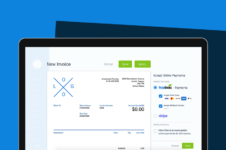Collect an upfront payment, or receive a portion of an overdue bill's remaining sum by asking your client for a Partial Payment.

Do you have clients who prefer to pay in installments? Or maybe you have a client that needs to spread out their payments as they navigate a short-term hurdle with their cash flow?
Then you might want to consider the Partial Payment option on your next invoice. It allows you to get paid a percentage upfront – acting as a security measure against not getting paid for your work once it’s completed. And it gives you the option of offering customers a bit of added payment relief if they need it. It’s available on FreshBooks Payments powered by Stripe and PayPal for all payment types.
Table of Contents
What Is a Partial Payment?
A Partial Payment refers to a payment your client can make for a portion of an invoice’s total amount. For example, if a client owes you $100, you can allow them to make a Partial Payment (or installment payment) of $50 to lower their total owed. This is useful when you want to receive a portion of a payment upfront, or when a client needs a bit of extra time to pay off an invoices full amount.
How Do I Enable Partial Payments?
The option to accept Partial Payments is already live in your account. All you have to do is enable Online Payments, and you will see the Partial Payments option on all future invoices you send out to clients. Here’s what it looks like on an invoice:
What Will My Client See On An Invoice?
Your client will see the option to pay with an Other Amount, instead of the total amount. Here’s what that looks like for them on an invoice:
Wait: How Are Partial Payments Different Than Payment Schedules?
Both Partial Payments and Payment Schedules allow you to receive payments in installments. However, Partial Payments allow your clients to pay any amount they want, whereas Payment Schedules have a set amount due on set dates. Both are a smart way to ensure you get paid for your work as you go, without having to use multiple invoices.
Why Should I Use Partial Payments?
Running a small business is all about nurturing client relationships. Partial Payments are a great way to put trust in your clients to pay what they can today, knowing that they will pay you the rest when they’re back on their feet.
It’s also an effective way to make sure you’re covered for a portion of your work upfront. You see this a lot in the real estate industry for example, where banks require a down payment upfront on a loan, with subsequent partial payments made monthly to pay off the rest. The same principle applies to invoice payments.
What If My Client Never Pays the Full Amount?
It happens… Unforeseen circumstances can mean a client has to fold their business, leaving you in the dark on payments. The best way to ensure everything is accurately reflected in your reports, is to add a Bad Debt line item on the invoice, with a negative amount equal to what you’re owed. This will zero the invoice out and ensure you can keep accurate records.
Alternatively, before you start your work, requesting a Partial Payment means you can at least get paid for a portion of your total amount – allowing you to avoid being left on the hook for your services.
Need Help Getting Started?
Payments are one of the most important pieces to running a successful business (especially if you are a freelance service supplier or contract worker). That’s why our support team is here to answer any questions you have. Contact them here.
Written by FreshBooks
Posted on August 30, 2022


 How to Setup an ACH Payment on FreshBooks in a Few Easy Steps
How to Setup an ACH Payment on FreshBooks in a Few Easy Steps Get Paid Faster With Advanced Payments, a Better Virtual Terminal
Get Paid Faster With Advanced Payments, a Better Virtual Terminal 10 Steps to Create a Simple and Effective Client Contract
10 Steps to Create a Simple and Effective Client Contract




